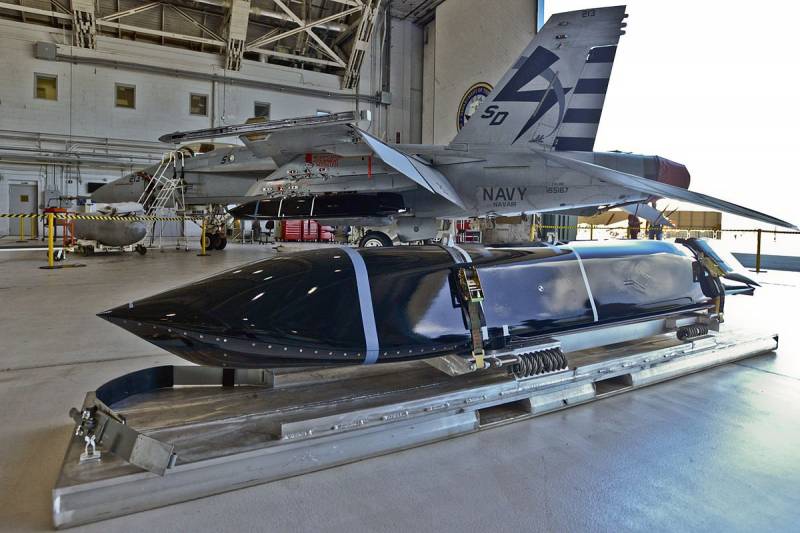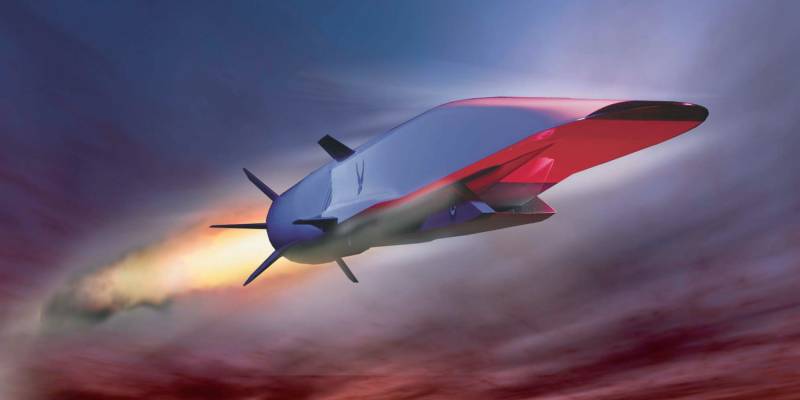Business Insider on Russian rocket armament
Over the past few weeks, the American edition of Business Insider has repeatedly raised the issue of the latest Russian missile systems. 23 March, an article entitled “The US Navy has a severe missile gap with China and Russia - was published” (“China and Russia went to the“ missile gap ”from the US Navy. How to defeat them?”) by Alex Loki. As is clear from the title, the subject of the publication was the current situation in the field of rocket weapons, as well as the consequences of the latest Russian and Chinese successes in creating new weapons.
A. Locky begins his article with a brief description of the current situation. US Navy still remains the most powerful fleet in the world, but the latest developments in China and the renewal of Russian missile arsenals have corresponding consequences. A new threat appears at sea, characterized by high range and speed characteristics. However, the US Navy and Lockheed Martin have ideas that will tip the scales in the direction of the United States in real combat.
The author recalls that over the years, the United States Navy has used the concept of distributed lethality (“distributed lethality”). The essence of this idea was to arm all ships and boats, even small and light ones, with the most powerful weapons, allowing you to strike at enemy targets at long range.
At the same time, the Russian and Chinese armed forces have already received new complexes with long-range missiles. The characteristics of such weapons make it possible to attack American ships long before approaching a small distance. In addition, both Chinese and Russian industry are now working on advanced hypersonic weapons that can fly five times faster than the speed of sound. Due to its speed, such a weapon will not leave even the hope of salvation for American ships.
A. Locki notes that the tension in relations between the USA, Russia and China has reached its peak in recent years. In particular, this is expressed in the fact that the Russian fleet, the marine aviation and coastal forces regularly threaten NATO ships, and the naval forces of the People’s Liberation Army of China, having received new weapons, prevent American forces from working normally in the South China Sea.
His vision of the current situation in the rocket industry was recently announced by the management of Lockheed Martin. Vice President of Tactical Missiles Chris Mang during a recent press conference held at the company's office in Arlington, made some interesting statements. First of all, he noted that defense is good, but the attack is even better. In addition, he recalled that leaving on their own will not shoot in the back.
C. Mang said that promising anti-ship missiles, such as the LRASM currently being developed (Long Range Anti-Ship Missile - “Anti-ship long-range missile”), can be put into service by the 2020 year. Such a weapon would allow the United States Navy to continue using the “See first, understand first, shoot first” strategy (“first saw, first figured, first shot”). The new LRASM rocket has a range of more than 200 nautical miles, carries an 1000 combat unit of pounds and hits targets, showing transonic speed of flight.
The new missile will also benefit the United States in another area that has not yet been adequately mastered by Russia and China - in naval aviation. According to the management of Lockheed Martin, over the next few years, work will be completed on integrating the LRASM rocket into the weapon system of various types of aircraft. Such weapons will be able to carry both F-18 fighter-bombers and B-1B long-range bombers. The first such results are planned to be received next year.
The author of the publication Business Insider notes that in the field of missile weapons, the United States is to some extent lagging behind competing countries. At the same time, the US Navy still has advantages in the field of radar systems, means of detection, monitoring and control. With the help of such equipment, ships will be able to notice the enemy earlier and react to it earlier, which will give a noticeable advantage in the event of hostilities.
Also Vice-President of Lockheed Martin touched upon the subject of hypersonic rocket armament and its use in the naval sphere. According to K. Mang, similar systems of American development are still far from practical application. However, the United States Air Force and the Advanced Development Agency DARPA are currently working on their own projects of such systems.
K. Mang also spoke about the possible characteristics of a new weapon. The hypersonic weapon differs in huge fuel consumption, and also is exposed to extremely high thermal loads. As a result, a truly fast flight may not last too long, and this limits the distance. The tactics of using such weapons should be as follows: the operator must be able to launch his hypersonic rocket before entering the zone of action of enemy weapons.
The naval forces continue to improve the combat information and control system of Aegis, as well as to increase the number of its carriers. Such equipment is proposed for use in the global missile defense system. In addition, with the help of such a CICS, it is proposed to “knock out” Russian and Chinese long-range missiles. In the future, the American information management system and related weapons should be able to combat hypersonic weapons.
A. Lokki completes his article with a curious thought. "On paper" the US Navy in some respects lose to the Russian and Chinese fleets. However, letters and numbers alone can never defeat the US Navy. Instead, the United States and its industry, represented by Lockheed Martin, continue to develop and improve their technologies in order to increase the capabilities of the armed forces in protecting the country.
***
The 6 of April edition of Business Insider published A. Loki’s new material titled “The US can't defend your new cruise missiles - try“ offense instead ”(“ The US cannot defend itself against the latest Russian cruise missile — perhaps instead protection should be attacked "), also devoted to the current situation in the field of missile weapons.

On the eve of the publication of the article, April 4, a meeting of the US Senate Armed Forces Committee was held, in which the head of the strategic command, General John Heithen, took part. During this event, the commander bluntly stated that the United States does not have good defense systems to counter the latest Russian-developed cruise missiles.
The general said that the United States could not defend itself against such a threat and, moreover, protect its European allies from it. New Russian missile weapons can threaten most of the European continent, depending on the area of deployment. All this causes serious concern, and therefore it is necessary to find a way to combat such threats.
A. Loki writes that the United States got into the existing situation not simply because of the technical superiority of Russia. He believes that the Russian complexes, which have become a cause for concern, violate the treaty on medium and short-range missiles - one of the most successful agreements in the field of disarmament. In fact, the INF Treaty prevented an increase in the number of nuclear weapons in Europe in the late eighties of the last century. Now the situation has changed. A number of experts in a conversation with the author of the publication Business Insider said that now Russia has the opportunity to attack any point in Europe from its territory.
At the same time, as the author notes, protection against cruise missiles is an extremely difficult task. Such weapons fly at high speeds and low altitudes. Because of this, the detection of missiles turns out to be an extremely difficult task for radar facilities, which are far from always able to find a flying object against the background of various objects, uneven ground, etc. Protection against cruise missiles throughout the European continent requires an advanced detection and tracking system - which in itself is far from a cheap solution.
An alternative to this may be a return to the previously used strategy. The United States may choose a different path, implying a warning to the Russian side against the use of medium-range missiles. The founder of the publishing house Arms Control Wonk, Jeffrey Lewis, told A. Loki about possible ways to solve the existing problem. To contain Russia can be used two basic methods of various kinds.
The first method of influencing the Russian side is the continuation of pressure on Russia. The United States must force Moscow to abide by the terms of the existing agreement on medium and short-range missiles. The second important method could be the beginning of a large number of advanced weapons development programs. Due to this, you can literally scare Russia and force it to act as necessary. To this end, J. Lewis, in particular, proposes to begin preparations for the deployment of land-based cruise missiles in Europe. Such weapons should be used if Moscow launches a banned rocket.
J. Lewis believes that the Russian side should be reminded why and under what circumstances the existing treaty on medium and short-range missiles appeared. He recalled that the Soviet Union quickly got rid of their arsenals, when it became clear that the United States would respond with similar measures. Also, the founder of the publishing house recalled that the United States wanted the INF Treaty because they did not want to deal with Soviet medium- and short-range missiles. At the same time, he calls for consideration of how dangerous US systems can be deployed, for example, in Poland, for example.
***
The reviewed publications of the American edition of Business Insider clearly demonstrate several basic ideas and opinions concerning the situation in the field of rocket weapons and have become widespread in the foreign press. As a result, these articles can be a good indicator.
The first material, “The US Navy has a more severe missile gap”, shows some features of the current reaction of foreign experts to Russian successes in the rocket industry. Experts are trying to predict what impact the latest Russian missiles can have on the course of a hypothetical conflict and the balance of forces in the oceans. In addition, the active quoting of a high-ranking executive at Lockheed Martin demonstrates a desire to show that the United States also has some success in the missile sphere.
The article “The US can't defend against the new cruise missiles - try it off, instead,” in turn, draws attention to the consequences of a strategic nature. At the same time, A. Lokki focuses on the incompatibility of Russian missiles with the existing international agreement. He claims that Russia's weapons violate the existing treaty on medium and short range missiles, and then tries to find possible answers to such threats.
It should be noted that the theme of a certain violation of the INF Treaty by Russia is not new. Over the past few years, foreign publications, primarily American ones, have been regularly writing about the testing of new Russian missiles, which allegedly fall under the limitations of the existing agreement. In addition, similar statements are heard from official representatives of various US government agencies. Until recently, such allegations concerned only promising ballistic missiles. For some time now, newer complexes with cruise missiles have appeared in such statements. Recent publications from Business Insider are a great example of this.
The presence of such accusations and the search for methods to counter the “Russian aggression” make it possible to suspect foreign authors and analysts of bias and bias. Nevertheless, it should be remembered that such views on current Russian work in the field of rocket weapons were widely spread and almost became the official point of view of the United States authorities.
The reference to the LRASM project in the context of the development of Russian and Chinese missile weapons is also of particular interest. Considering foreign successes, the American press does not forget to recall the existence of its own projects of a similar purpose. At the same time, along with a simple mention, there are indications of certain advantages of the American missile system. So, the author recalled the imminent emergence of the possibility of equipping the most diverse aircraft carriers with promising missiles.
In general, recent articles in the publication Business Insider and other foreign media allow us to draw a number of conclusions. Abroad, we really noticed the effect of the newest Russian attack missile systems, studied the use of such systems and made certain conclusions. In this regard, there are various assumptions regarding the protection against such weapons during a hypothetical conflict. At the same time, attempts are being made to expose Russian developments that do not meet the requirements of relevant international agreements. This may be an attempt to find a reason for this or that pressure on Russia, including with a view to reducing its advantages in the missile sphere.
It is obvious that the Russian armed forces and the defense industry will continue to develop missile systems of various classes, and in the future they will show new successes in this field. Existing and future progress is unlikely to please the foreign military, which will lead to the corresponding expected consequences. There will be new attempts to predict the future, to create an effective defense, or to counteract with the help of indictments.
The article "The US Navy has a severe missile gap with China and Russia -
http://businessinsider.com/missile-gap-us-navy-russia-china-lrasm-2017-3
The article "The US can't defend against the new cruise missiles - try it offense instead":
http://businessinsider.com/russia-inf-cruise-missile-us-no-defense-offense-2017-4


Information